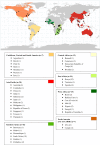Characteristics and comprehensiveness of adult HIV care and treatment programmes in Asia-Pacific, sub-Saharan Africa and the Americas: results of a site assessment conducted by the International epidemiologic Databases to Evaluate AIDS (IeDEA) Collaboration
- PMID: 25516092
- PMCID: PMC4268491
- DOI: 10.7448/IAS.17.1.19045
Characteristics and comprehensiveness of adult HIV care and treatment programmes in Asia-Pacific, sub-Saharan Africa and the Americas: results of a site assessment conducted by the International epidemiologic Databases to Evaluate AIDS (IeDEA) Collaboration
Abstract
Introduction: HIV care and treatment programmes worldwide are transforming as they push to deliver universal access to essential prevention, care and treatment services to persons living with HIV and their communities. The characteristics and capacity of these HIV programmes affect patient outcomes and quality of care. Despite the importance of ensuring optimal outcomes, few studies have addressed the capacity of HIV programmes to deliver comprehensive care. We sought to describe such capacity in HIV programmes in seven regions worldwide.
Methods: Staff from 128 sites in 41 countries participating in the International epidemiologic Databases to Evaluate AIDS completed a site survey from 2009 to 2010, including sites in the Asia-Pacific region (n=20), Latin America and the Caribbean (n=7), North America (n=7), Central Africa (n=12), East Africa (n=51), Southern Africa (n=16) and West Africa (n=15). We computed a measure of the comprehensiveness of care based on seven World Health Organization-recommended essential HIV services.
Results: Most sites reported serving urban (61%; region range (rr): 33-100%) and both adult and paediatric populations (77%; rr: 29-96%). Only 45% of HIV clinics that reported treating children had paediatricians on staff. As for the seven essential services, survey respondents reported that CD4+ cell count testing was available to all but one site, while tuberculosis (TB) screening and community outreach services were available in 80 and 72%, respectively. The remaining four essential services - nutritional support (82%), combination antiretroviral therapy adherence support (88%), prevention of mother-to-child transmission (PMTCT) (94%) and other prevention and clinical management services (97%) - were uniformly available. Approximately half (46%) of sites reported offering all seven services. Newer sites and sites in settings with low rankings on the UN Human Development Index (HDI), especially those in the President's Emergency Plan for AIDS Relief focus countries, tended to offer a more comprehensive array of essential services. HIV care programme characteristics and comprehensiveness varied according to the number of years the site had been in operation and the HDI of the site setting, with more recently established clinics in low-HDI settings reporting a more comprehensive array of available services. Survey respondents frequently identified contact tracing of patients, patient outreach, nutritional counselling, onsite viral load testing, universal TB screening and the provision of isoniazid preventive therapy as unavailable services.
Conclusions: This study serves as a baseline for on-going monitoring of the evolution of care delivery over time and lays the groundwork for evaluating HIV treatment outcomes in relation to site capacity for comprehensive care.
Keywords: HIV care capacity; HIV/AIDS; clinic characteristics; comprehensive care; resource-limited settings.
Figures
References
-
- Joint United Nations Programme on HIV/AIDS (UNAIDS) Global report: UNAIDS report on the global AIDS epidemic 2013 [Internet] 2013. [cited 2013 Oct 8]. Available from: http://www.unaids.org/en/resources/campaigns/globalreport2013/globalreport/
-
- WHO. WHO; 2010. Priority interventions: HIV/AIDS prevention, treatment and care in the health sector (2010 version) [Internet] [cited 2013 Oct 8]. Available from: http://whqlibdoc.who.int/publications/2010/9789241500234_eng.pdf.
-
- Mills EJ, Nachega JB, Buchan I, Orbinski J, Attaran A, Singh S, et al. Adherence to antiretroviral therapy in sub-Saharan Africa and North America: a meta-analysis. JAMA. 2006;296(6):679–90. - PubMed
Publication types
MeSH terms
Grants and funding
- R24-AI067039/AI/NIAID NIH HHS/United States
- U01AI069924/AI/NIAID NIH HHS/United States
- P30 AI094189/AI/NIAID NIH HHS/United States
- P30 AI054999/AI/NIAID NIH HHS/United States
- P30 MH043520/MH/NIMH NIH HHS/United States
- U01 AI069923/AI/NIAID NIH HHS/United States
- P30-AI036219/AI/NIAID NIH HHS/United States
- P30-AI094189/AI/NIAID NIH HHS/United States
- R24 AI067039/AI/NIAID NIH HHS/United States
- U01AI069907/AI/NIAID NIH HHS/United States
- R01 AA016893/AA/NIAAA NIH HHS/United States
- P30 AI027767/AI/NIAID NIH HHS/United States
- R01-AA16893/AA/NIAAA NIH HHS/United States
- UL1 TR000445/TR/NCATS NIH HHS/United States
- K24 DA000432/DA/NIDA NIH HHS/United States
- U01 AI096186/AI/NIAID NIH HHS/United States
- U01 DA036935/DA/NIDA NIH HHS/United States
- U01AI069911/AI/NIAID NIH HHS/United States
- P30-AI50410/AI/NIAID NIH HHS/United States
- U01AI069918/AI/NIAID NIH HHS/United States
- U01A096299/PHS HHS/United States
- U01 AI069911/AI/NIAID NIH HHS/United States
- K24-DA00432/DA/NIDA NIH HHS/United States
- U01AI069919/AI/NIAID NIH HHS/United States
- P30-AI27757/AI/NIAID NIH HHS/United States
- K24-AI065298/AI/NIAID NIH HHS/United States
- U01 AI069919/AI/NIAID NIH HHS/United States
- U01A1096186/PHS HHS/United States
- U01 AI069918/AI/NIAID NIH HHS/United States
- UL1-TR000083/TR/NCATS NIH HHS/United States
- K24 AI065298/AI/NIAID NIH HHS/United States
- U01 AI069907/AI/NIAID NIH HHS/United States
- N02 CP055504/CP/NCI NIH HHS/United States
- UL1 TR000083/TR/NCATS NIH HHS/United States
- P30 AI027757/AI/NIAID NIH HHS/United States
- KL2 TR000421/TR/NCATS NIH HHS/United States
- U01AI069923/AI/NIAID NIH HHS/United States
- P30-AI27767/AI/NIAID NIH HHS/United States
- R01-DA11602/DA/NIDA NIH HHS/United States
- U01-DA036935/DA/NIDA NIH HHS/United States
- P30 AI036219/AI/NIAID NIH HHS/United States
- U01 AI069924/AI/NIAID NIH HHS/United States
- P30 AI050410/AI/NIAID NIH HHS/United States
- P30-AI54999/AI/NIAID NIH HHS/United States
LinkOut - more resources
Full Text Sources
Other Literature Sources
Medical
Research Materials


